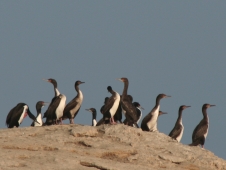
The realisation that seabird excrement (guano) had excellent properties as a fertiliser transformed western agriculture. For over a century the sale of guano was the single greatest source of income in Peru but, by the turn of the twentieth century, reserves had been nearly exhausted.
In the early industrial era cities began forming as the powerhouses of national economies. Feeding their populations became increasingly critical as farmland soils became steadily depleted of nutrients. The realisation in 1840 that seabird guano had excellent properties as a fertiliser transformed not only western agriculture but western interests in the economic value of seabird colonies, although none ever rivalled those to be found along the coast of Peru, where weather conditions had allowed the accumulation of guano over millenia.
Between 1848 and 1875 Europe and North America consumed over 20 million tons of Peruvian guano, most of it dug out by convicts and conscripts. In circles where the massive profits were spent the Guanay Cormorant Phalacrocorax bougainvillii was toasted as “the most valuable bird in the world”. For over a century the sale of accumulated deposits of bird excrement was the single greatest source of income in Peru. By the turn of the twentieth century the depletion of reserves was sufficiently worrying for the country to create the State Guano Company to promote more sustainable extraction, but the damage was largely irreversible. The immense reserves on the Chincha Islands (which the Spanish tried to appropriate from Peru in the mid-1860s) had been exhausted, and all the others were in a near-terminal state. The walling-off of colonies and the stationing of guards had some effect, and finally a rotational system of extraction, once and briefly every few years, was installed to try to maintain the industry and the colonies in balance. But by the mid twentieth century other nations had realised that they could “cut out the middleman”—the birds themselves—by catching the fish they were eating and processing them directly into fertiliser. The result, inevitably, was a further massive crash of the Peruvian seabird stock and the guano it produced, as birds simply starved (Collar et al. 2007).
Related Species
References
Collar, N. J., Long, A. J., Robles Gil, P. and Rojo, J. (2007) Birds and people: bonds in a timeless journey. Mexico City: CEMEX.
Compiled: 2008
Recommended Citation:
BirdLife International (2008)
Seabird guano, especially from Peru, transformed western agriculture in the nineteenth century.
Downloaded from https://datazone.birdlife.org/sowb/casestudy/seabird-guano-especially-from-peru-transformed-western-agriculture-in-the-nineteenth-century on 22/12/2024